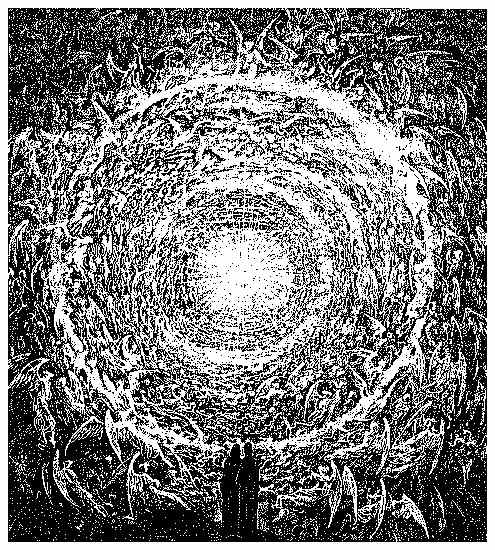| ~ |
From Mandala to Meander
In Book One, Part One, the Garden was seen as a place of
containment and order, as a safe mandalic enclosure. In
the Wilderness the symbolism makes a right-angle turn into an
untamed landscape of shifting sands, and for what will prove to be a very long meandering
journey.
If the Garden was a watered place of comfort and consolation,
the Wilderness is where the soul experiences alienation and barrenness.
If the Garden was where the soul walked and talked with God along
bordered paths, the Wilderness is where it finds itself alone
and uncertain of the way.
As the journey had its beginning in the edenic womb of unconscious
wholeness, so in the Wilderness the soul becomes conscious
of being lost. "When a man believes himself to be utterly lost," Luther posits, then it is that "light breaks."(1)
Having sensed its separation, the soul now seeks its return. Having set its sights towards the light, the soul now progresses towards those radiant beings who, having completed their own journeys, serve now as the attracting force--as the enlightened beings composing Dante's spiraling Celestial Rose. (Figure 1)
|
|
|
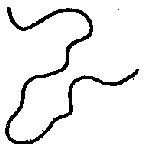
The Path of a Meandering River
Figure 2 |
Fretting towards Wholeness
Corresponding to Dante's imagery of Purgatory is the slow, repetitive rhythm by which the Israelites make their
way back to the Promised Land. Both Purgatory and Wilderness speak of how
consciousness is gained progressively--in stages. The Israelites, in slow, recursive twistings
and backward turnings transverse a meandering
course. Time and again, when they are nearly there, the labyrinthian
path takes them back out and away from their goal. For forty
years they are led round and round over increasingly familiar-feeling territory.
Does their meandering course begin to sound familiar? In like
manner do we not also travel time and again over the same emotional
territory? The familiar jab of an old jealousy here? The fear
of failing again there? Or the recurring nag of old anxieties,
guilts, angers? In these and numerous other ways the soul frets
its way towards wholeness. It meanders according to a
pattern so named after the winding Miandros River. (Figure
2)
|
|
| ~ |
The Labyrinth as a Pattern of Movement
A labyrinth is a stylized meander. As a pattern of movement
it is symbolic of the soul's journey back to God by way of
the Wilderness. Dr Max Oppenheimer, a professor of foreign
languages, notes that in Arabic the word for labyrinth is matahah
which means "wilderness, desolate barrenness, wasteland."(2)
From within its pathways the overall design of a labyrinth is
obscured. Only when viewed from above is its path seen as purposefully
ordered and deliberately leading to the center. A prime example
is the Labyrinth in Chartres Cathedral which dates back to the
Thirteenth Century when it was popularly called Chem de Jerusalem--a
"Journey to Jerusalem" for stay-at-home pilgrims. (Figure
3).
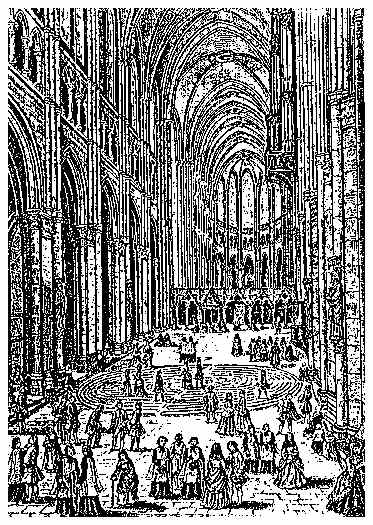
An 18th Century Engraving of the Chartres Labyrinth
Figure 3 |
|
|

The Fret, Key, or Meander Motif
Figure 4

|
Remnants of another design, known as the "Classical," "Cretan," or "Seven-Circuited"
labyrinth, have been found all over the world. For the Hopi the design symbolized Mother
Earth; while on the coins of ancient Crete, sometimes the motif was centered by a rose, sometimes by a crescent moon, indicating devotion to the Goddess as both Mother and Virgin.
In a remarkable way, the Hopi/Cretan Labyrinth evolves out of a
familiar pattern. (Figure 4)
English geomancers, Jeff Saward and Nigel Pennick,(3) have demonstrated
how when two units of the above pattern are rotated a full 360
degrees (one axis moving, one remaining fixed), the result is
a Seven-Circuited Labyrinth. (Figure 5)

The Conversion of Meander into Labyrinth
Figure 5
Still another type of meander (Figure 6) suggests a path of movement similar to the one the Israelites
followed from their point of departure in Egypt to their place of
entrance into the Promised Land. In design, meander and maze differ from the Classical Labyrinth in which the same path that leads to the center
also leads back out again. The Wilderness is the maze--the chaos--that must be gone through on the way from one state of consciousness to another.
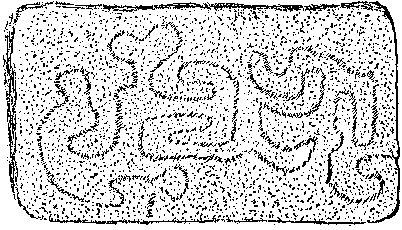
A Stone-etched Native American Meander(4)
Figure 6
|
|
| ~ |
Moving Towards Resolution
In 1988, inspired by the labyrinth research of Saward and Pennick, and with the help and enthusiasm of friends and neighbors, we created a Seven-Circuited Labyrinth in a meadow on our Sierra foothills ranch.
Using a knotted rope
for a compass, and after marking out the design with cornmeal, we placed stones from the
creek--one right next to the other--so as to create the alternating--clockwise/counter-clockwise--path to the center. Over the years the many who walk
it repeatedly describe their experiences as "centering,"
"quieting," "balancing," "healing."
(The Murray Creek Labyrinth)
Walking a Labyrinth is a symbolic way of moving from an outer
to an inner place--from the periphery of outer activity to a still
center of peace within. Correspondingly, the Wilderness is a
symbolic movement between two states of mind: an edenic or unconscious
state of awareness; through an unsettling transition of feeling
lost; but continuing on until a new state or level of consciousness--the
Promised Land--is attained.
Following a meandering path also can be a way of moving
towards a resolution, particularly when one's peace of mind has been upset,
perhaps by a disturbing dream, or an attack of anxiety, or an outburst of emotion.
In these circumstances movement that is circular and repetitive
has a way of bringing the source of the disturbance into
focus--into the center--there to be seen from other points of view--reviewed from all angles--thus broadening and balancing one's perception of the situation. In this
manner, we are restored to that state of mind the Bible calls Jerusalem--City
of Peace--and which the Psalmist describes as a city that is "at
unity with itself."(5)
|
|
|
~ |
Nature's Pattern of Movement
In walking a maze, a labyrinth, or some other meandering path,
the course that is followed winds first one way and then the other,
thus imitating one of nature's favorite ways of slowing things
down. Moreover, the quieting rhythm has the effect of
calming the spirit. I recall my mother telling me
that when something would be troubling my grandmother she
would get down on her hands and knees and scrub the floor--whether
it needed it or not. And that when she would get up and stand
back to admire her "clean-enough-to-eat-off-of-floor,"
whatever the trouble had been would appear to have been resolved.
Of course, that was before the age of psychotherapy. And it
is also true that much in our ancestors' lives went unresolved
and has been left to subsequent generations to work out. Nevertheless,
our lives are the better when they include movements that have
the power to restore our sense of harmony and inner peace.
Weaving, knitting, even doodling, are kinesthetic ways of experiencing
what it is to move more slowly and circularly, going for a while
in one direction and then another, one way giving way to another,
in a manner similar to a river winding its way to the sea--or
the soul back to its Source.
In Patterns in Nature, Peter Stevens explains how and why
the river winds and turns so as to slow down its movement.
At first we might suppose that the river follows the terrain,
that it twists and bends in direct response to peaks and dips
in the landscape. . . . [However, even] on a smooth and gentle
slope, we find that water does not flow straight downhill; it
wanders back and forth like a skier running a slalom.(6)
According to Stevens, the bends of a river are predictable. "The
windings turn out to be surprisingly regular, quite independent
of subtle changes in topography." The curves of rivers are
"elliptic integrals" (Figure 7) which have
the exceptional characteristic of being the smoothest of curves,
of having the least change in the direction of their curvation.(7)

How Rivers Curve Elliptically
Figure 7
Contrary to what we may have thought, the slow meandering way by
which the Israelites moved through the Wilderness just may have been the best
possible way for attaining their goal, at least when considering that
consciousness, like the river, is gained slowly and in accord with a wisdom
inherent to the nature of the soul.
|
|
| ~ |
The Dry and Thirsty Land
In the Wilderness the soul learns what it is to hunger and thirst
not for what satisfies the physical, mortal body but for what
satisfies the deeper longing of the eternal Self. It is this
dry and thirsty inner landscape about which the Psalmist wrote:
Eagerly I seek you;
my soul thirsts for you,
my flesh faints for you,
as in a barren and dry land
where there is no water.
Psalm 63:1
In the symbolism of the Wilderness, the mystic, the depth psychologist
and the alchemist share a common language and a common goal.
Their point of convergence is their concern with the soul's formation
into a vessel of Spirit. The Wilderness is both where and how
this takes place. It is therefore the "extremity" that
is God's "opportunity."
|
|
| ~ |
The Alchemist's Calcinatio
Stark and empty, the limestone Wilderness of the Bible is a place
of dry bones made white by the sun's relentless rays. For the
mystic it is the first of a three-fold progression from purgation
to illumination to union. For the alchemist it is the stage of
the opus known as the calcinatio. Edinger points
out that most alchemical images derive in part from chemical procedures.
Calcinatio relates to a drying-out process that involves
intense heat. The result is quicklime--a whitened, powdery substance.
Alchemically, this whitened "fire" acts on the nigredo--the
soul's darkness--so as to purge and purify.
When quicklime is mixed with water a catalytic reaction creates
an intense, internal heat, a heat that is inherent to the quicklime
but inert until quickened by being moistened. If the mixture
in its fluid state is poured into a mold it will "cure"
into the shape of the mold. For the medieval alchemist and mystic,
Christ was the mold into which their souls were being poured.
Most of us, when we were children, experimented with a process
in which we mixed plaster of paris with water and poured it into
a mold. What would have made our experiments "alchemical"
would have been our intent and awareness that what we were doing
outwardly had an inner correlation. Something ordinary was in
the process of being transformed into something extraordinary--something
as base as lead into something as beautiful and valuable as gold.
For the alchemist, the "chemical" procedure "rang
true" or "bore witness" to a corresponding spiritual
truth.
As Edward Edinger observes in his book on the symbolism of alchemy, when Jung discovered the writings of the alchemists, they struck in him a resounding chord:
I had very soon seen that analytical psychology coincided in a
most curious way with alchemy. The experiences of the alchemists,
were, in a sense, my experiences, and their world was my world.
This was, of course, a momentous discovery: I had stumbled upon
the historical counterpart of my psychology of the unconscious.(8)
|
|
| ~ |
Igniting the Inner Fire
For the alchemist each of the four elements was relevant to a
particular stage of the opus. For the calcinatio
it was fire, a fire inherent to this stage of the transmutation
process but inert until activated. Corresponding
to the symbolism of the calcinatio is the mystic's impassioned
desire for union with God--to be divinely enflamed.
Similarly, in order for individuation to be initiated there must
be a quickening within the psyche. Moreover, once ignited the inner fire
must be kept burning; otherwise better it had been left unlighted,
for fear of falling under the scathing indictment of the church
of Laodicea:
Would that you were cold or hot! So, because you are lukewarm,
and neither cold nor hot, I will spew you out of my mouth.(9)
In both the alchemists' calcinatio and the Israelites'
Wilderness ordeal, the soul's purgation is a process by which the hidden or unconscious
"dross" is exposed to the light of consciousness,
and in that light--that fire--is consumed. For those aspects
of a person's life that are being lived out of egocentricity
this stage of the process amounts to a "trial by fire"--to
subjection to an internal heat, but
from which ashes, as with the mythical Phoenix, the soul emerges
reborn. Figure 8
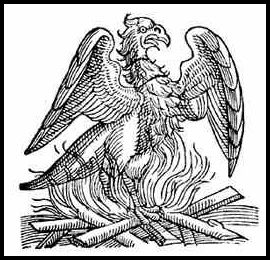
The Phoenix rising from its self-inflicted
exposure to the full force of the sun's rays (10)
Figure 8
|
|
| ~ |
The Scriptural Basis for Purgatory
The symbolism of Dante's Purgatorio, in addition to paralleling the symbolism
of the Wilderness, corresponds as well to the depth psychology
of the alchemist. Edinger, in fact, sees the "doctrine"
of purgatory as "the theological version of calcinatio
projected onto the afterlife."(11) He cites Paul as the
scriptural origin of the purgatorial imagery in which the theme
of "salvation in Christ" is presented as a trial by fire.
. . . if anyone builds on the foundation with gold, silver, precious
stones, wood, hay, stubble--each man's work will become manifest;
for the Day will disclose it, because it will be revealed with
fire, and the fire will test what sort of work each has done.
If the work which any man has built on the foundation survives,
he will receive a reward. If any man's work is burned up, he
will suffer loss, though he himself will be saved, but only as
through fire.(12)
The Wilderness is the refining furnace in which the wood, hay
and stubble are consumed. But it is also where the gold, silver,
and precious stones are revealed.
In the legend of the Phoenix, as its lifespan nears an end, it
gathers twigs and resin into a nest on which it then sits until
the intense heat of the desert sun sets both nest and bird on
fire, but out of which ashes it arises reborn.
In a Wilderness experience, at the same time the unconscious underpinnings
of a person's life are being exposed to the light of consciousness,
the soul's desire for God is intensifying,
and so consuming all lesser desires. In this way the soul experiences
what the legend of the Phoenix, as well as the alchemist's calcinatio,
symbolize.
|
|
| ~ |
Letting Go of self-Will
In the Garden, the central motif was a fountain from which four
rivers flowed out and around in a balanced rhythmic symmetry so
as to form a pattern of movement around a center. As long as
the center held the image was one of wholeness and connectedness.
But in the Wilderness the old center has let go and the new one
has yet to be established. For now the image of wholeness is lost.
Movement is disordered and diffused. The symmetry and balance
of the Garden are lost.
Jeremiah provides a pertinent illustration: One day Yahweh, wishing
to instruct Jeremiah concerning his relationship with Israel,
tells the prophet to go down to the shop of the potter and watch
him at work at his wheel. When Jeremiah arrives he observes the
hands the potter shaping and forming a vessel of clay as the wheel
turns round and round. But as Jeremiah looks on he sees the clay
begin to wobble and the vessel to teeter off balance. From side
to side it flops about until finally it collapses in on itself.
The vessel is spoiled. But the potter, all in a day's work,
simply picks up the clay and reworks it "into another vessel,
as it seemed good to the Potter to do."(13)
Jeremiah understood that Yahweh was the Potter and Israel the
clay. Relevant to our contemporary lives, God is still the Potter but
the individual soul is Israel--is the clay. And as with Israel,
the Wilderness is the phase of the spiritual journey where the
soul is formed and reformed, until, like the clay under the Potter's
hands, it learns to let go of self-will.
|
|
| ~ |
Reordering Priorities
Human nature is multi-leveled, each level with a will of its own:
the instincts willing one thing; the ego another; and the Self
still another. Each also has a hierarchy of conflicting priorities.
The Wilderness necessitates a reordering of these priorities.
What previously were considered "necessities," in the
Wilderness are reduced to "amenities." But here also,
while days are directed towards what is essential to survival,
nights afford time for soul considerations: for
measuring the hardships of the moment against the hope of eternity.
In this natural balance between day and night and body and
soul, the ego's sense of importance is all but left out. For
the ego, with all its complex needs, the Wilderness is a time
of being emptied and diminished. But it also affords the ego an opportunity
to gain a new perspective from which to re-evaluate its own
dim light against the brilliance of the starry sky, and to measure
its self-importance against the immensity of the heavens. For
the soul the Wilderness is an opportunity to gain true
humility.
|
|
| ~ |
The Nekyte
Because the Wilderness symbolizes the vast unclaimed, untamed
territory of the unconscious, the account given in Exodus is descriptive
of a prolonged encounter with the unconscious. Its overall symbolism
is suggested in its beginning crossing of the Red or Reed Sea.
Not surprisingly, the mythological roots of this crossing are
found in the Egyptian symbolism of the Nekyte, or Night
Sea Journey. Here night is the realm of the unconscious and sea
is the collective or archetypal psyche.
In crossing the sea the Israelites were embarking on a journey
that corresponds to the one the sun makes nightly in its descent
from the western sky and as it travels under the sea and through the
realm of darkness, moving eastward and unseen until it re-emerges with the
light of a new day. The symbolism is that of life/death/rebirth--the
rhythmic heartbeat of ongoing creation.
In its rising and falling, the sun corresponds to the experience
of alienation which occurs with a similar regularity as the
ego alternately and cyclically experiences inflation followed
by deflation. Its deflation feels like death, but in its rising
up it feels once more in control. This, however, sets another
cycle in motion that takes it back down again into unconsciousness.
The cycle of alienation is, according to Edinger, the way consciousness
increases incrementally until a point is reached where the ego/Self
axis of communication is sufficiently strengthened so that the
inflation/deflation extremes can be modified through an ongoing
inner dialogue between ego, instinct and Self.
Edinger has observed that Eden was paradisal because consciousness
had not yet appeared and there was therefore no conflict pressing
for resolution.(14) Here again, the Wilderness is opposite to
Eden in that it is where what is hidden and unresolved is brought
to light. With each descent and awakening of consciousness
our eternal lives are being saved from the oblivion of unconsciousness.
In Jungian terms, the path through the Wilderness is the path
of individuation, a commitment to which, Edinger notes, there
is no turning back:
the prolonged dealing with the unconscious--the chaos or prima
materia--that is required following an irrevocable [emphasis
mine] commitment to individuation . . . [is a] transition between
personal, temporal existence (ego) and eternal, archetypal life
(Self). Thus the forty years of wandering in the wilderness signify
a nekyia or night journey from the ego-bound existence
of Egypt to the transpersonal life of the Promised Land.(15)
|
|
| ~ |
Dark Night of the Soul
The biblical account of the Wilderness journey contains symbols,
images and metaphors that are relevant to those times when unconscious
contents press upwards into the foreground of our lives, inundating
and thus confounding and overpowering the conscious mind. Such
an experience is comparable to the phase of the mystic's journey
called the Dark Night of the Soul. In this Night the ego is defeated
in its efforts to remain master of the soul. Its loss of power
is a death that both alienates and purges. St John of the Cross
describes not just one dark night but one that is followed by
a still darker night:
The first purgation or night is bitter and terrible to sense,
. . . . the second bears no comparison with it, for it is horrible
and awful to the spirit.
For this Divine purgation is removing all the evil and vicious
humours which the soul has never perceived because they have been
so deeply rooted and grounded in it; it has never realized, in
fact, that it has had so much evil within itself. But now that
they are to be driven forth and annihilated, these
humours reveal themselves, and become visible to the soul because
it is so brightly illumined by this dark light of Divine contemplation
. . . .(16)
|
|
| ~ |
Alienation
In seeing the Wilderness as the classic symbol for alienation,
Edinger describes it as the "necessary prelude to awareness
of the Self." He quotes Kierkegaard:
. . . so much is said about wasted lives--but only that man's
life is wasted who lived on, so deceived by the joys of life or
by its sorrow that he never became eternally and decisively conscious
of himself as spirit . . . which gain of infinity is never attained
except through despair.(17)
Wilderness is, in fact, synonymous with alienation. It
is the long drawn-out process by which the ego is emptied of self
will. As a rule a person is driven into the Wilderness
by some inner or outer compelling circumstance: as when Adam was
"driven" from the garden;(18) or Cain "banished"
to the Wilderness as a fugitive.(19) Jacob, also, having aroused
his brother's fury, was forced to "flee" for his life.(20)
And Joseph, having provoked his brothers' jealousy, was first
"thrown into a pit" and then sold into slavery.(21)
Moses' fate was similar when, having killed the Egyptian, he
"escaped" into the Wilderness.(22) Even Abraham experienced
estrangement when he was sent by God from his kindred and his
native land in order to receive The Promise that from his descendants
a great nation would arise.(23)
|
|
| ~ |
Barrenness
What alienation was to the forefathers of Israel, barrenness
was to the women. If the Wilderness was where the soul was made
ready for the seeds of God consciousness to take root, barrenness
was the pattern for the wives of Abraham, Isaac and Jacob. Having
known barrenness they could conceive "the first fruits"
of the new potential for consciousness.
First there was Sarah who, at age ninety, laughed when told she
would conceive. Then there was Rebecca for whom Isaac "prayed
to the Lord . . . because she was barren."(24) And even
though Jacob fathered the twelve sons who became the twelve tribes,
Rachael, the only true love of his life, was also barren. Finally,
however, she did give birth first to Joseph and later to Benjamin.
And although Jacob dearly loved Benjamin, it was a love saddened
by the death of Rachael at his birth. Again of Hannah it was
said that "the Lord had closed her womb," but opened
it when she fervently prayed for a son, and Samuel was born.
In the New Testament, Elizabeth was past childbearing years when
John the Baptist was born. In each of these biblical cases barrenness
preceded the conception of a child who became a noteworthy servant
of God.
Symbolically understood, barrenness is the soul empty of self
and surrendered and receptive to God's will. It is therefore
a soul within which the seeds of spiritual awareness can come to
fruition.
|
|
| ~ |
Wounding and Healing
In alienation the thing that is lost is the old order of one's
life. It is the loss of what formerly had seemed fulfilling,
a loss of one's hard-won adaptation to life. In alienation the
ego falls from its place as king pin. Due to a combination of
circumstances, one's life is propelled into a crisis, one that
even may be life-threatening. Fears, doubts, deep anxieties surface.
Old issues and whatever other demons are waiting in subconscious
recesses appear or reappear. The outcome, even in victory, is
both wounding and healing; as when Jacob wrestled with the angel
until he "prevailed" and received from the angel a blessing,
but ever after walked with a limp."(25)
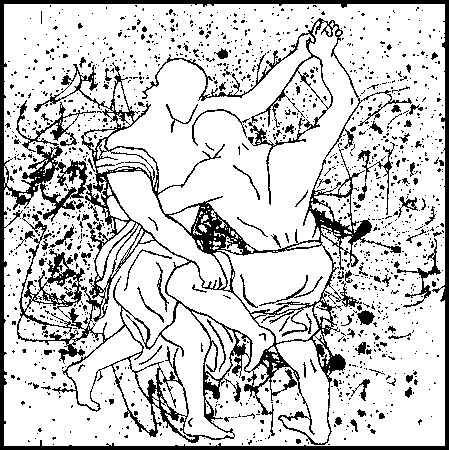
Jacob Wrestling with the Angel
Figure 9
Most Jungians, I assume, see Jacob's angel as his shadow,
and his victory two-fold: the overcoming of his fear of Esau's
revenge; and his release from guilt over having "stolen"
Esau's Blessing. Even though he "prevailed" during
that long dark night, he endured a fear so terrible that it left
its mark. He was able to endure because something in him wouldn't
let go until he "owned" rather than justified his wrong
doing, and saw his deceit for what it was. Empathy was born in
Jacob that night as he imagined himself in Esau's shoes and how
painfully hurt his brother had been by what he had done. It was
this that enabled Jacob, the very next morning, to humble himself
before Esau and, as a result, receive his brother's forgiveness.
|
|
| ~ |
The Fate of Icarus
Jung speaks of the "defeat of the ego" as when we come
to the realization that the ego--the "I" that we thought
we were--is no longer the master of our life. The "I"
has become divested of its self-importance. The result can be
devastating, as with Adam when he was driven out of Eden into
a strange land, estranged also from God whose spirit had breathed
life into him. Thus separated from his origins, his sense of
acceptance and his self-esteem were also stripped away. He no
longer knew who he was or the purpose for which he had come into
being. Adam's expulsion from the Garden, in addition to being
individually relevant, also speaks portentously of a collective
time of alienation which marks each evolutionary transition
away from unconsciousness towards a new and greater level of consciousness.
In Ego and Archetype Edinger spells out the "cycle
of alienation": how and why the breach between ego and Self
occurs and how the connection is restored. Alienation, he explains,
is the hubris brought upon through the ego's identification
with the Self. This is the sin of pride, of presumption. When
the ego identifies with the Self, presuming to be God, it becomes
inflated and brings upon itself "the fate of Icarus."
Like Icarus the ego insists on following its own course; becomes
exhilarated by its ability "to fly;" flies too close
to the sun; its wax wings melt; and Icarus falls into the sea.
The flight is its inflation; the sun its self-exaltation; the
wax wings its vulnerability; and the sea its deflationary fall
back into unconsciousness.
Through repetitions of the cycle of alienation, and particularly
as we experience the consequences, we come to recognize the ego's
self-defeating patterns and the telltale signs of its inflationary
attitudes. Here again it is Edinger who helps us identify our
inflationary tendencies by which we also fly too close to the
sun:
Power motivation of all kinds . . . . Whenever one operates out
of a power motive omnipotence is implied. . . . Intellectual
rigidity which attempts to equate its own private truth or opinion
with universal truth . . . [This] is the assumption of omniscience.
Lust and all operations of the pure pleasure principle . . .
. Any desire that considers its own fulfillment the central value
transcends the reality limits of the ego and hence is assuming
attributes of the transpersonal powers.(26)
The illusion of our own physical immortality is another
aspect of inflation. Edinger explains why a close call with death
is so often a humbling and a soul-awakening experience:
There suddenly comes a realization of how precious time is just
because it is limited. Such an experience not uncommonly gives
a whole new orientation to life, making one more productive and
more humanly related. It can initiate a new leap forward in one's
development, because an area of ego-Self identity has been dissolved,
releasing a new quantity of psychic energy for consciousness.(27)
|
|
| ~ |
Dante's Wilderness
In the Divine Comedy Dante's "wilderness" was
a "forest" which he entered through the gateway of a
mid-life crisis. His entrance was signaled by a "darkening"
or "confounding" of his conscious mind--the dark night
of his soul.
In our own journeys, the onset of a time of transition is typically
felt as a time when the meaning and purpose of life seems to have
run out. Without being able to pinpoint why, something is not
working. The direction of life feels wrong. The flow of life
feels blocked. Doubts, fears, and confusion plague the mind.
There is a sense of being entangled or trapped. But at the same
time one feels urged and compelled on, towards some unknown but
more satisfying goal in life. Thus Dante found himself at the
entrance into a "dark wood."
The wildness of that rough and savage place,
The very thought of which brings back my fear!
So bitter was it, death is little more so.(28)
Helen Luke sees, in Dante's words, the image of a man stumbling
about in darkness without any sense of direction. In other words
one who is "lost" in the psychological sense of the
word.
but the poet is surely also telling us in those few words that
it is precisely through the terrifying experience of the dark
wood that we find the way of return to innocence; that indeed
it is because of his lost state that a man is able consciously
to refind himself.(29)
Dante had awakened to the fact that the light, the meaning and
purpose of his life, had gone out. He had lost the sense that
his life was going somewhere. The forward movement had come to
a halt. He was stuck. Moreover, he seemed helpless to get his
life back on track. Something like this happens to each of us
wherever or whenever it is in life that we wake up to the realization
that we are stumbling around in the dark, and that our complacent
goals of power, success, respectability, rebellion, uplift, or
a thousand others are empty and meaningless.(30)
|
|
| ~ |
The Narrow Gate
Entering into a "dark wood" is similar to the "narrow
gate" described by Jesus as leading to life. Kunkel enumerates
what must be left behind
All security, all guarantees, . . . not only health, mammon, the
old-age pension, and life-insurance, but also reputation, social
standing, and religious merit. Moreover, the gate is so narrow
that only single individuals can pass through it. The group,
the tribe, the community, even the new brotherhood, have to be
left behind.
The gate can be found at the end of our physical career, or between
two periods of our life; or there may be many gates of different
degrees of narrowness. The narrow gate symbolizes rebirth.(31)
In light of Jungian thought, to enter through the narrow gate
is to be put in conflict with our most basic and for the most
part unconscious attachments to life. The wide gate is
the way of unconsciousness; the narrow gate the way of consciousness.
The wide gate is unchallenging: The narrow gate is wrought with
conflict, is, in fact "bought" with conflict. No wonder
so few choose the one, and so many, by not choosing, opt for the
other.
The Life That Is Lost / The Life That Is Found
Fritz Kunkel identifies "the core of Christianity" in Jesus'
statement concerning the necessity of "losing" one's
life in order to "find" it and which seems to ask that
we let go of all we hold dear in the areas of physical comfort,
temporal security, and social standing. Another way of understanding
what it is to "lose" one's life is offered by Elizabeth Boynton
Howes(32). She suggests we examine the self-protective
walls by which we "hedge in" "the vital spark of
being." We spend our whole lives, she says, building these
walls through our "defenses, evasions and excuses."
In hiding behind our walls we hide not only from others but also
from God and even from our own true selves. These self-imposed
barriers cut us off from life itself. The result is a loss of
savor for life. In our attempt to "save" ourselves
from the emotional hurts and pain of life we lose the opportunity
life affords us for enlarging our souls in preparation for eternal
life.
|
|
| ~ |
The Wilderness of Sin
For the Israelites the Sinai Wilderness was their place of despair,
a despair repeatedly attributed to sin. In fact, throughout
the Bible there is so much talk of sin that it is impossible to
seriously study the scriptures without coming to terms with this
word. Edinger points out that St John of the Cross' "dark
night of the soul," Kierkegaard's "despair," and
Jung's "defeat of the ego" all refer to the same experience,
to an awareness of lostness, of separation, of sin. Sin
in this sense is not an act but a state. And if so, it is also
the way we are found and therefore "saved." In Luther's
words:
God works by contraries so that a man feels himself to be lost
in the very moment when he is on the point of being saved. When
God is about to justify a man, he damns him. Whom he would make
alive he must first kill. God's favor is so communicated in the
form of wrath that it seems furthest when it is at hand. Man
must first cry out that there is no health in him. He must be
consumed with horror. This is the pain of purgatory . . . In
this disturbance salvation begins. When a man believes himself
to be utterly lost, light breaks.(33)
|
|
| ~ |
The Hero's Journey
In as much as the path through the Wilderness is the path of individuation,
it is the archetypal hero's journey of becoming. It is the stage
upon which egocentricity is transformed into ego strength, which
in turn is the distinctive mark of the hero or heroine whose influence
extends beyond his or her own personality. Erich Neumann notes that
the hero is one "who is destined to bring [the] new order
into being and destroy the old."(34)
[He,] the hero, like the ego, stands between two worlds: the inner
world that threatens to overwhelm him, and the outer world that
wants to liquidate him for breaking the old laws. Only the hero
can stand his ground against these collective forces, because
he is the exemplar of individuality and possesses the light of
consciousness.(35)
John Sanford, referring to Moses' birth as following the pattern of
a hero, adds "but this did not guarantee he would become
a hero."
Before the seed of a potential hero in him could develop, the
young Moses had to undergo a process of psychological development
and transformation. As with Jacob and Joseph before him, his
egocentricity had to be destroyed, so that his life could be molded
by the Greater Will within him."(36)
As clay upon the Potter's wheel each of our lives is being raised up,
sometimes into a fit vessel, but other times collapsing in on
itself. Thus we are shaped and reshaped, formed and reformed,
"as it seems good to the Potter to do." all the
while learning how to let go, how to yield self-will, what
it is to will one thing--to will the will of the Higher Will--and
so submit to the process by which the soul is formed into
a vessel of Spirit.
|
|
| ~ |
Illustration Credits
1. Gustave Dore, from Illustrations for Dante's Divine Comedy,
Dover,
2, 4, 7, the author
3. 13th Century engraving, reproduced in Labyrinths, their
Geomancy and Symbolism, by Nigel Pennick, Runestaff--Old English,
1986
5. Nigel Pennick after Jeff Saward, Labyrinths
6. After illustration in Mazes & Labyrinths, by W H
Matthews, Dover, NY 1922, Pictograph from Mesa Verde
8.
9. Pen & ink drawing by Marianne Elliott
Endnotes
1. Roland Bainton, Here I Stand, Abingdon-Cokesbury NY, 1950, pp 82
2. Max Oppenheimer, "On Labyrinths and Mazes--Meandering & Musings," in Labyrinth Letter, Vol 1, No.2, July 1995, 10550, E San Salvador, Scottsdale AZ 85258-5744
3. Nigel Pennick, Labyrinths: their Geomancy and Symbolism, Runestaff, England, 1986, p 5
4. W H Matthews, Mazes and Labyrinths, Dover, NY, Original, London, 1922
5. Psalm 122:3
6. Peter S Stevens, Patterns of Nature, Little/Brown, Boston, 1974 pp 92-3
7. Ibid
8. Edward F Edinger, Anatomy of the Psyche, Open Court, La Salle IL, 1985, p1
9. Revelations 3: 15-16
10. J E Cirlot, A Dictionary of Symbols, Philosophical Library, NY, 1962 p 253
11. Op cit, Edinger, p26
12. 1 Corinthians 3:11-15
13, Jeremiah 18:4
14. Edward F Edinger. Ego and Archetype, Penguin Books, Baltimore, 1973, p 17
15. Edward F Edinger, The Bible and the Psyche, Inner City Books, 1986, Toronto, pp 51-2
16. St John of the Cross quoted in The Soul Afire, p 256-259H A Renhold, Editor, Meridian Books NY 1960
17. Op cit Edinger, Ego and Archetype, p 48-50 and Fear and Trembling, the Sickness Unto Death, by S Kierkegaard, Garden City, NY, Doubleday Anchor Books, 1954, p 159.
18. Genesis 3:24
19. Genesis 4:12
20. Genesis 28:43
21. Genesis 37:28
22. Exodus 3:15
23. Genesis 12:1-2
24. Genesis 25:21
25. Genesis 32:31
26. Op cit, Edinger, Ego & Archetype, p 15
27. Ibid
28. Dante, Divine Comedy, I i, Lawrence Grant White translation, NY Pantheon
29. Helen Luke, Dark Wood to White Rose, Dove, Pecos NM, 1975, p 9
30. Ibid
31. Fritz Kunkel, Creation Continues, Word Books, Waco TX 1973, p 109
32. Elizabeth Boynton Howes, Jesus' Answer to God, Guild for Psychological Studies, San Francisco, 1984, p128-130
33. Roland Bainton, Here I Stand, Abingdon-Cokesbury NY 1950, pp 82f
34. Erich Neumann, The Origins and History of Consciousness, Bollingen, Princeton 1970, p175
35. Ibid, p380
36. John A Sanford, The Man Who Wrestled with God, Paulist Press, NY, Revised Edition, 1987, p83
|
|
| ~ |
|
|
